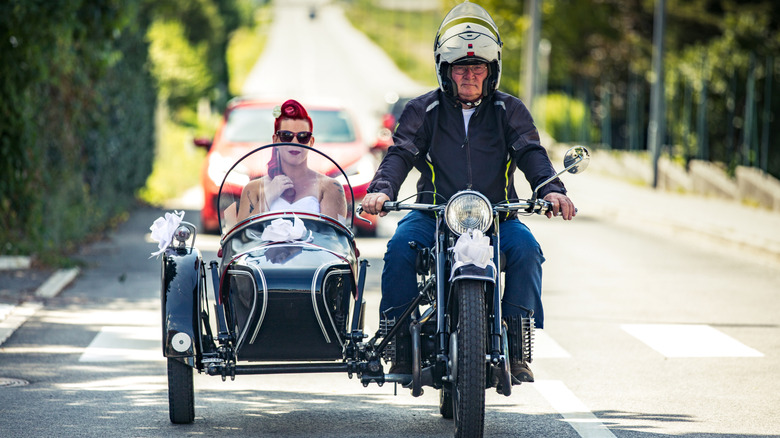Can You Put A Sidecar On Any Motorcycle?
Motorcycles — and indirectly, sidecars — have long given a sense of freedom to those who love riding the open road. With wind whipping through your hair (metaphorically or real, based on a state's helmet laws), there's something magical about riding a motorcycle that just can't be replicated any other way. Perhaps that's because there are still some genetic strands hardwired into our DNA that harken back to the days when our only mode of "high speed" transportation was riding a horse.
Whatever the case, not everyone has the wherewithal to actually climb aboard a motorcycle, but will have no problem hopping into an attached sidecar, which still satiates the need for speed without having to handle the stressful driving duties. Despite the romantic nostalgia of sidecars, only one motorcycle company still makes bikes with a sidecar straight from the factory, and that's Russia-based Ural Motorcycles, which has more or less been the premier sidecar brand since the 1940s.
Technically, you can put a sidecar onto any motorcycle. However, that simple answer is far from being as straightforward as it seems. Sure, you can attach a sidecar to virtually any bike. The real question, though, is whether you want to invest the time and money necessary to make modifications to the bike in order to complete the transformation. In some cases, the answer may be no, because unless you can find one for your exact ride, structural changes may be necessary to offset the sidecar's added weight and unique handling characteristics.
Sidecars let you bring your sidekick along for the ride
Before investing your hard-earned money and time, check local regulations to ensure that modifying your bike is legal, and whether your current motorcycle license requires a specific endorsement to operate a sidecar. The easiest way to check these laws is through your local DMV, as rules can vary drastically by state.
Several companies make third-party sidecars, such as Champion, Watsonian Squire, DMC, Hannigan, and Diamonado (which builds fully articulating sidecars). Each designs and builds sidecars for a variety of bikes, including Harley-Davidson (which stopped building its own sidecars in 2011), Royal Enfield, BMW, Triumph, Honda, and even Vespa. According to Cycle World, you can expect the cost of a sidecar to be approximately half as much as the bike itself. However, some money can be saved if you have the necessary skills and tools to build your own. Regardless of the direction you choose, there are some crucial factors to consider.
The motorcycle needs to have the requisite power to handle the extra weight of not only the sidecar, but the passenger (both of which can vary greatly). As such, motorcycles powered by a 750cc engine are generally preferred since they'll be able to take on all that added weight. The strength of the bike's frame and suspension also needs to be factored into the equation, but with how precisely each company has dialed in its specifications, picking the right one should be fairly straightforward. Mounting a sidecar alters the bike's steering, handling, and braking, and thus may require some retraining to understand these changes better.
